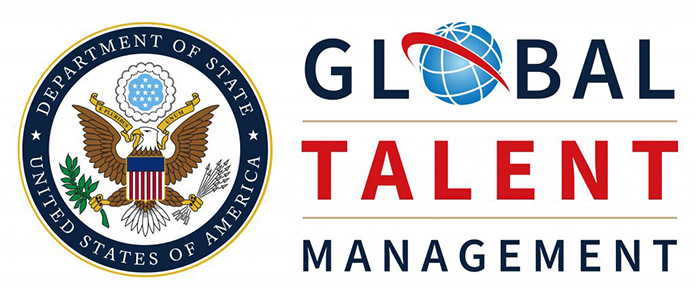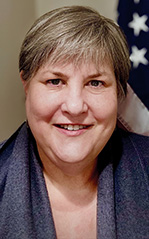The New Core Precepts and What They Mean
After the first significant overhaul since 2015, the State Department core precepts are lean and tuned to the diplomatic requirements of the 21st century.
BY LISA VICKERS

Director General Carol Perez addresses a large group of employees on modernization steps at the State Department in February 2020.
Isaac D. Pacheco

In February, Director General Carol Perez announced new core precepts for State Foreign Service tenure and promotion, which will take effect in the rating cycle beginning this month. The new core precepts mark a significant change from the previous ones. Here is an explanation of how they are different, the process for developing them and why the precepts matter. You can find the full text of the new core precepts at https://usdos.sharepoint.com/sites/Intranet-HR/offices/pe.
Every employee evaluation report (EER) season for the Foreign Service, employees around the world agonize over their personal narratives and assemble bullet points for their rater and reviewer. The most effective way to organize the narrative is by consulting the core precepts, which are the decision criteria for tenure and promotion. Like many of you, I go through the current table of precepts (which some refer to as a “bingo card”) to make sure that my EER touches on as many of the subcompetencies as possible. I also read my last three EERs to make sure that I didn’t forget to include something and to decide where this year’s narrative journey will take me.
As director of the Office of Performance Evaluation in the Global Talent Management Bureau, I am responsible for renegotiating the core precepts with the American Foreign Service Association every three years. The core precepts are—for me—the most important document I consult when writing EERs. For each one I write, I look at how the employee’s accomplishments demonstrate their potential to succeed at the next higher level for each individual precept. The performance conversations I’ve had with employees through the year already give me a good sense of where the employee is truly shining and where they could use some mentoring, which makes the writing that much easier.
A Careful and Inclusive Process
The core precepts are key to everything I do as a Foreign Service officer, and so it was an honor to work with AFSA on renegotiating the precepts in 2021. They have not undergone a significant overhaul since 2015, when we ushered in the three effectiveness areas: informational, operational and relational. This time, Director General Perez asked our team to really scrub the core precepts and ask, are these appropriate to a 21st-century diplomatic service? What we found was that while there certainly was a lot of good to work with, there was also a lot that we could do to make them more effective.
From the beginning, it was clear that we needed to make greater substantive changes to the precepts than in previous years. We took the steps and the time we needed to get the new precepts right.
The process for arriving at the new core precepts was just as important to us as the precepts themselves. The State Department is a large organization, and change does not come easily. Any change you make, you need to be able to explain the reasoning and benefits to justify how you got there. We first assembled a working group, with representatives from a cross-section of skill codes and grades, which was reflective of the department’s diverse workforce. Our process needed to be as inclusive as we wanted our new precepts to be.
From the beginning, it was clear that we needed to make greater substantive changes to the precepts than in previous years.
We reviewed all existing precept-like elements, including the performance pay precepts used by the senior levels, leadership and management principles that apply departmentwide, the 13 dimensions used in selection to join the Service, etc. We looked at feedback from hundreds of those who have served on selection boards to determine what skills and qualities they viewed as most important—and which ones they thought were important but were missing from the existing precepts. We consulted with stakeholders internally and held multiple discussions with AFSA.
The finished product is reflective of the effort the working group and our partners both in and outside the building put into creating a document that will work for the entire Foreign Service.
The Changes and Their Rationale
Our team quickly zeroed in on several critical components and changes that would have a significant, positive impact.
First, we needed a version of the core precepts that was easier to use. We started with a version that was 15 pages long and pared it back to six. We got rid of the “bingo card” in favor of a streamlined paragraph format. And we sought to reduce redundancy across the precepts by going from six down to the following five core competencies: Communication; Diversity, Equity, Inclusion & Accessibility (DEIA); Leadership; Management; and Substantive and Technical Expertise. Nothing substantive from the existing precepts was lost—we simply updated and combined the elements of the existing precepts into a new framework. Each of these new core competencies is important in its own right. Selection boards weigh all competencies equally, and no one precept is more important than another.
We also eliminated the three effectiveness areas. This was in response to feedback from employees that it was confusing trying to write to both the effectiveness areas and to the precepts. To avoid confusion, for employees as well as for the selection boards, we went back to the model of simply relying on the core competencies.
Second, we needed to make the new core precepts more inclusive of Foreign Service specialists. The existing core precepts were more geared toward generalists, who are more likely to gain experience related to foreign policy reporting and outreach to foreign audiences. While those elements are still present in the new version, we have also elevated skills more readily applicable to the work of specialists, and have been clear that the relevant elements and skills should apply on an as-appropriate basis.
Last, we asked what qualities, skills, abilities and actions needed greater emphasis as we continue to build a stronger Foreign Service, and it was clear that we needed a stronger focus on DEIA. We have a responsibility to integrate DEIA principles into the way our institution achieves its mission. In close coordination with Chief Diversity and Inclusion Officer Ambassador Gina Abercrombie-Winstanley, and others throughout the department, we developed a dedicated precept to ensure every employee takes responsibility for fostering DEIA and demonstrates that responsibility through action.
The other components we elevated were supervisory excellence, strategic risk-taking and learning from failure.
In addition to DEIA, we also increased our emphasis on data literacy. The way we do work has changed; today our employees need to make data-driven decisions and policies, so they need to know how to interpret data. While these are skills that entry-level employees may not come into the Service with, we now offer courses on data literacy at the Foreign Service Institute to make sure every officer has the tools needed to succeed.
The other components we elevated were supervisory excellence, strategic risk-taking and learning from failure, institution building, and careerlong learning and development.
Without a doubt, the most significant change is the addition of the precept on DEIA, and it is a critical one for our organization as we look to retain and develop our diverse talent and to make State a place where people look forward to coming to work each day. Our concern was that we didn’t want commitment to DEIA to simply be a box-checking exercise. We wanted to send an unequivocal message to the workforce that it is everyone’s responsibility to do their part to make the department an equitable, inclusive and fair place to work.
We believe that the new DEIA precept includes competencies each employee can demonstrate on a daily basis. For example, exhibiting cultural awareness, achieving goals through inclusive teamwork, and showing support for workplace flexibilities are all activities that employees can readily exhibit at every level. Employees can also engage in more robust ways through work with DEIA-related programming and advocating and implementing policies that will make our workplace more equitable and inclusive.
Why the Precepts Matter
On a practical level, selection boards use the core precepts as the basis for their assessment of a candidate’s readiness for tenure and promotion. The feedback we receive from the boards indicates that the better job employees do of describing the impact of their work, of demonstrating the ability to operate successfully at the next level within each precept, the easier it is for selection boards to determine employees’ promotability. Every board season, we give each board member a copy of the core precepts and advise our members to keep referring to the precepts throughout the process.
When I came into the Foreign Service, I was an unconed officer. The core precepts set the tone for what the State Department expected of me as an officer. In essence, the precepts were the basis for the agreement between the department and me to become a Foreign Service officer. Today, the core precepts continue to serve as guideposts. While we are an incredibly diverse workforce, we are united by these common elements that each of us aspires to progressively demonstrate.
Read More...
- “The new 2022 Foreign Service Core Precepts,” Path to Foreign Service, February 17, 2022
- “Revitalizing the Core Precepts,” by Tom Yazdgerdi, The Foreign Service Journal, September 2021
- 3 FAH-1 H-2320: Promotion of Foreign Service Members, State Department, December 6, 2021






